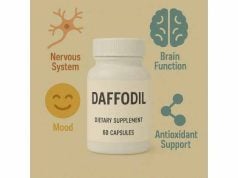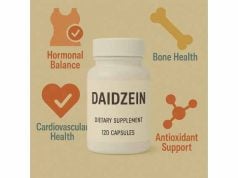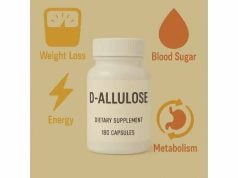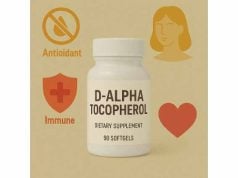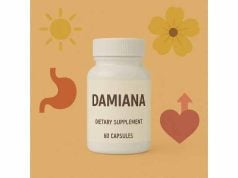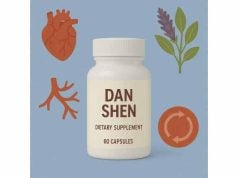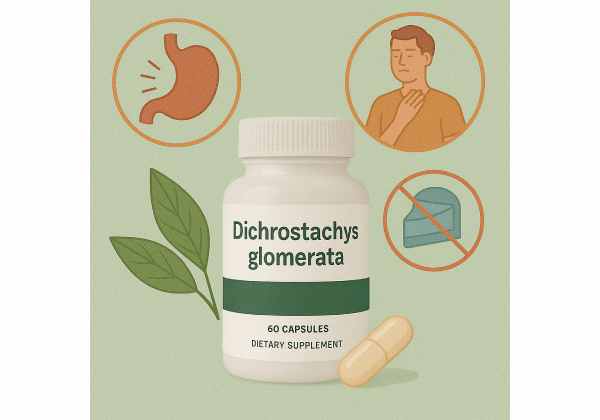
Dichrostachys glomerata is a West and Central African spice made from the dried fruit pods of a small legume tree in the Fabaceae family. Beyond its culinary role in traditional soups, standardized extracts of the pods are now studied as dietary supplements for weight management, metabolic health, and antioxidant support. Early human trials report modest weight loss and improvements in cravings and mood, while laboratory and animal research points to antioxidant activity and possible effects on lipid and glucose pathways. The pods are rich in polyphenols, including myricetin and luteolin, which likely contribute to these effects. Safety data in animals are reassuring, and short human studies report few adverse events. This guide covers what it does, how to use it, realistic benefits, who should avoid it, and how to evaluate quality if you decide to try it.
Quick Dichrostachys glomerata Highlights
- May support small additional weight loss and reduce food cravings in 60 days.
- Antioxidant polyphenols and AMPK-related activity are proposed mechanisms.
- Studied daily doses: 300–400 mg of standardized fruit pod extract.
- Avoid if pregnant, breastfeeding, under 18, or on glucose or lipid medicines without medical advice.
Table of Contents
- What is Dichrostachys glomerata?
- Benefits for weight and metabolic health
- How to use it day to day
- How much should I take per day?
- Side effects, interactions, and who should avoid it
- What does the research say today?
What is Dichrostachys glomerata?
Dichrostachys glomerata is a spice and medicinal plant native to West and Central Africa, especially Cameroon, where the dried fruit pods flavor the traditional “Nah poh” soup. In supplements, you will usually find a powdered or hydroethanolic extract of the pods, sometimes marketed under standardized trade names derived from the plant’s scientific designation. Taxonomically, some floras list D. glomerata under the broader species complex of Dichrostachys cinerea; in commerce and research, “Dichrostachys glomerata” remains the name used on labels and in papers. For a buyer, the practical takeaways are consistency and standardization: choose products that clearly identify the plant part (fruit pods), extraction solvent, and standardization markers.
Why the growing interest? The pods are unusually rich in polyphenols and other phytochemicals. Analyses report flavonoids such as myricetin and luteolin present in measurable amounts, alongside tannins and other phenolics. In cell and animal models, these compounds are linked with antioxidant, anti-inflammatory, and metabolic effects. One mechanistic line of evidence suggests the extract can influence AMPK signaling, a cellular “fuel gauge” that shifts metabolism toward energy use rather than storage. While mechanisms from non-human models should never be over-interpreted, they provide a plausible map for the modest effects seen in early human trials.
Traditional uses focus on flavoring and general wellness. Modern supplement uses target weight management, lipid profiles, and oxidative stress support. Importantly, D. glomerata is not a stimulant; in trials it has not consistently changed appetite hormones dramatically but has been associated with improved cravings and small reductions in body weight over 8–12 weeks when paired with usual diet and activity. That makes it a potential adjunct, not a replacement, for nutrition and movement.
Quality varies. Whole spices may be smoked or sun-dried; granulometry (particle size) and extraction method influence polyphenol yield. Controlled sieving and ethanol-water extraction tend to concentrate antioxidants more effectively than coarse powders. Look for third-party tested brands that quantify key flavonoids or total polyphenols and disclose solvent systems. If you prefer culinary use, buy intact pods from reputable vendors and store them away from heat and light to preserve potency.
Finally, be aware of naming overlaps. Some retailers may conflate D. glomerata with other West African spices; verify the Latin name on the label. If an extract lists only “Dichrostachys” without species, or if it uses vague proprietary names without plant part or standardization, consider another brand with clearer documentation.
Benefits for weight and metabolic health
Weight management
A randomized, double-blind, placebo-controlled trial in overweight and mildly obese adults found that 300 mg per day of a standardized fruit-pod powder for 60 days produced greater weight loss than placebo, along with improvements in food cravings and several mood and quality-of-life measures. The absolute weight change was modest—on the order of a few pounds over two months—which is consistent with a supportive supplement rather than a stand-alone intervention. Another controlled human study with 12-week supplementation at 400 mg per day reported reductions in body fat percentage and favorable shifts in anthropometric measures. Together, these results suggest an adjunct role for D. glomerata in lifestyle-based weight reduction.
Lipids and cardiometabolic markers
In animal models of diet-induced obesity, standardized extracts reduced total and LDL cholesterol, free fatty acids, and liver enzymes, while increasing the HDL to LDL ratio. Early human data align directionally—showing decreases in total and LDL cholesterol and C-reactive protein in small trials—though the magnitude varies and not all endpoints reach statistical significance across studies. As with many botanicals, effects appear incremental and likely depend on baseline diet, adherence, and duration.
Glycemic control and cravings
Cell work using liver-derived HepG2 cells shows that D. glomerata extracts can help rescue glucose uptake under oxidative stress, and some studies report small reductions in fasting glucose in animals and humans over several weeks. In the 60-day human trial, participants taking the extract reported fewer food cravings. Improved cravings can help with adherence to diet changes, which in turn amplifies the effect of any supplement.
Antioxidant and inflammatory tone
Multiple lines of evidence indicate robust antioxidant capacity: high phenolic content in the pods, strong performance in ORAC and FRAP assays, and improvements in oxidative stress markers (e.g., lower malondialdehyde, higher SOD and catalase activity) in animals fed high-fat diets. In individuals with metabolic syndrome, exploratory work has associated the extract with improved inflammatory markers. While antioxidant claims are common in supplement marketing, the particular strength here is the convergence across chemistry, cells, animals, and early human signals.
Mechanistic plausibility
A preclinical paper identified activation of AMPK signaling in adipocytes and white adipose tissue, with down-regulation of adipogenesis and lipogenesis markers and up-regulation of lipolysis proteins. This offers a coherent mechanism for the small changes in body fat and lipids observed clinically. Still, mechanistic insights are hypothesis-generating; clinical endpoints matter most.
Realistic expectations
If you plan to use D. glomerata for weight or metabolic health, set expectations appropriately. The best projections from current data are: small added weight loss over 8–12 weeks, slightly better cravings management, and modest improvements in select lipid or inflammatory markers, especially when combined with a calorie-aware diet and regular activity. Individual responses vary, and not all trials are large or long enough to draw firm conclusions. Use it as a nudge, not as a substitute for fundamentals.
How to use it day to day
Choose your form
You can use D. glomerata in two main ways:
- Culinary spice: Whole dried pods simmered in soups or stews for aroma, then removed before serving. This is traditional and safe, but polyphenol yield is variable and depends on pod quality, grind size, and cooking time.
- Standardized extract: Capsules providing a defined amount of pod extract (often 300–400 mg per day). This is the form tested most in modern studies and offers consistent dosing.
Timing and pairing
Most trials used once-daily dosing with or before a meal. Taking the capsule with lunch or dinner may reduce any chance of mild stomach upset and fits easily into routines. For culinary use, simmer pods for 15–30 minutes to extract flavor; if you grind them, finer fractions release more antioxidants but can impart bitterness. Combining the spice with fat sources (e.g., palm oil substitutes such as olive oil) may aid extraction of lipophilic constituents during cooking.
Lifestyle stack
D. glomerata pairs well with evidence-based lifestyle steps:
- Diet: A moderate calorie deficit (e.g., 300–500 kcal/day) plus higher protein and fiber improves the odds that a supportive supplement translates to visible results.
- Activity: Aim for 150–300 minutes of weekly moderate activity and two resistance sessions. Even in neutral-calorie trials, participants who stayed active tended to see better changes in waist and hip measures.
- Cravings plan: Because one RCT found reduced food cravings, capitalize by planning satisfying, protein-rich meals and having high-fiber snacks available. This turns a subjective change into better adherence.
Quality and label savvy
Pick products that specify: plant part (fruit pods), extraction solvent (e.g., 50–70 percent ethanol in water), standardization markers (e.g., total polyphenols or named flavonoids), capsule dose, and third-party testing. Be cautious with multi-herb blends that do not quantify each component. If the label uses a proprietary name, the company should still disclose the botany and standardization.
What about stacking with other botanicals?
Some individuals combine D. glomerata with gentle thermogenic or glucose-supportive botanicals. Keep stacks simple and avoid overlapping effects on glucose or lipids unless supervised by a clinician—particularly if you use prescription agents. More ingredients do not guarantee better outcomes; they do increase interaction complexity.
Travel and storage
Store capsules cool and dry; keep pods in airtight containers away from heat and light. Polyphenols degrade with moisture and prolonged high temperatures. If you bulk-buy pods, consider splitting into smaller containers to limit repeated exposure to air.
When to stop or switch
Evaluate after 8–12 weeks. If you see no changes in weight, waist, cravings, or energy—and you have been consistent—either discontinue or re-center on diet and activity before trying a different approach. Supplements are tools; the right tool is the one that helps you do the work.
How much should I take per day?
Studied doses
Controlled human studies have evaluated 300 mg per day for 60 days and 400 mg per day for 12 weeks of standardized fruit-pod extract. These are the clearest reference points for practical use. Most products supply 300–400 mg per capsule; follow the label unless your clinician advises otherwise.
Suggested starting plan
- If new to botanicals: Start with 300 mg once daily with food for two weeks. If well tolerated and you want to mirror higher-dose protocols, increase to 400 mg once daily thereafter.
- Timing: Take with lunch or dinner to minimize the chance of mild gastrointestinal effects.
- Cycle length: Reassess at 8–12 weeks. Some users continue for another 8–12 weeks if benefits persist and labs or vitals remain stable.
Standardization matters
Because potency depends on polyphenol content, choose products that either report total phenolics or provide validated marker compounds. Research formulations have identified myricetin (~1.6 percent) and luteolin (~1.0 percent) as measurable markers in the finished extract. Not all consumer products disclose these, but brands that do are generally more rigorous.
Culinary equivalents
Culinary use is not straightforward to equate to capsule dosing. Depending on pod quality and preparation, a single serving of soup may provide far less—or, occasionally, comparably more—polyphenols than a capsule. If you prefer food-first:
- Use intact pods and simmer them; grind only what you need.
- Finer fractions release more antioxidants but taste stronger.
- Consider combining regular culinary use with a lower supplement dose if you want both flavor and consistency.
Special populations
- Older adults: Start low (300 mg) and monitor for appetite or weight changes, especially if unintentional weight loss is a concern.
- Athletes cutting weight: The cravings support may help adherence to a moderate deficit; avoid severe calorie restriction which undermines training quality.
- People tracking lipids or glucose: If you change your supplement routine, recheck labs after 8–12 weeks to see if it is helping and to avoid over-treatment when combined with prescription agents.
Do not exceed label directions without medical supervision. Higher doses have been evaluated in animals for safety, but translating those limits to humans requires caution and clinical context.
Side effects, interactions, and who should avoid it
What people report
In short human trials at 300–400 mg per day, D. glomerata has been well tolerated. The most common complaints, when they occur, are mild and transient: gastrointestinal discomfort, bloating, or nausea. Isolated reports in comparator groups (e.g., palpitations) have occurred but were not consistently attributed to the extract. Because products differ, your experience may depend on capsule excipients and timing with meals.
Safety backdrop
A 90-day subchronic animal study found no treatment-related toxicity at doses far above human intakes and no signal for genotoxicity in standard assays. That supports a favorable safety margin for short-term use of standardized extracts at typical supplemental doses. However, animal no-effect levels are not human dosing recommendations; they simply reduce concern about unexpected toxicity at normal capsule amounts.
Potential interactions
- Glucose-lowering medications: Because some data suggest small improvements in fasting glucose and enhanced glucose handling under oxidative stress, caution is prudent if you use insulin or sulfonylureas. Monitor for hypoglycemia and coordinate with your prescriber.
- Lipid-lowering agents: Supplements that modestly lower LDL or triglycerides can, in combination with statins or fibrates, change lab results; monitor rather than assuming benefit.
- Anticoagulants and antiplatelets: Polyphenol-rich extracts occasionally interact with these pathways; while no specific signal is documented for D. glomerata, a conservative approach is to confirm with your clinician.
- Pregnancy and lactation: There are no quality human data. Avoid use.
- Surgery: Stop two weeks before planned procedures.
Who should avoid it
- Pregnant or breastfeeding individuals (insufficient safety data).
- People under 18 (no pediatric research).
- Anyone with active liver disease or unexplained elevated liver enzymes (seek medical supervision first).
- People on complex regimens for diabetes or dyslipidemia unless their clinician agrees and monitors labs.
Allergy and tolerability
If you have known allergies to legumes, proceed carefully; D. glomerata is in the Fabaceae family. Start with a low dose and discontinue with any rash, itching, or breathing difficulty. For gastrointestinal discomfort, taking with a larger meal or reducing the dose usually solves the problem.
Long-term use
We lack robust long-term safety data in humans beyond a few months. If you choose to use D. glomerata for extended periods, build in breaks (e.g., 8–12 weeks on, 4 weeks off) and monitor bloodwork annually or as advised by your clinician.
What does the research say today?
The human evidence base is growing but remains early-stage. The clearest signals come from two modern randomized, placebo-controlled trials using standardized fruit-pod preparations:
- 60 days at 300 mg/day: In overweight and mildly obese adults, participants taking the extract lost more weight than placebo and reported lower food cravings, with parallel improvements in perceived stress and health-related quality of life. The absolute weight change was modest but statistically significant; the trial was CONSORT-compliant and used validated questionnaires in addition to scale weight.
- 12 weeks at 400 mg/day: In adults with excess weight, supplementation was associated with lower body fat percentage by dual-energy X-ray absorptiometry and favorable changes in anthropometric and select blood markers. This points toward an effect on adiposity rather than water weight alone.
Mechanistic and supportive lines include:
- AMPK and adipocyte biology: Mouse and cell studies show activation of AMPK, reduced lipogenesis and adipogenesis, and increased lipolysis-related proteins in white adipose tissue.
- Antioxidant capacity: The pods have high total phenolic content; in vitro assays (ORAC, FRAP) rank D. glomerata among the stronger antioxidant spices in regional comparisons.
- Glucose handling under stress: In HepG2 cells, extracts rescued impaired glucose uptake caused by oxidative stress, aligning with the idea of improved metabolic resilience.
- Nutrient density and processing: Powder fractionation studies demonstrate that finer particle sizes concentrate minerals, vitamins, carotenoids, and antioxidant activity—an insight relevant to both culinary use and supplement manufacturing.
Safety is underpinned by a 90-day NOAEL at the highest tested dose in rats with no genotoxic signal across standard assays. Human trials up to 12 weeks have reported few adverse events. That said, most studies are short and sponsor-linked; independent replications, longer durations, and larger samples are needed. Outcomes such as long-term weight maintenance, cardiovascular events, or diabetes incidence have not been studied.
Bottom line: D. glomerata is a promising adjunct for weight and metabolic wellness with a favorable short-term safety profile and biologically plausible mechanisms. Expect incremental benefits when combined with diet and activity, and rely on standardized products that mirror the doses and extraction methods used in published trials. As the literature expands, stronger guidance on dose-response, durability, and subgroups (e.g., by baseline metabolic status) should emerge.
References
- Efficacy of Dichrostachys Glomerata Supplementation on Overweight and Mildly Obese Adult’s Weight, Mood, and Health-Related Quality of Life: A Randomized Double-Blind Placebo-Controlled Trial (2024)
- Anti-Obesity Effect of Dyglomera® Is Associated with Activation of the AMPK Signaling Pathway in 3T3-L1 Adipocytes and Mice with High-Fat Diet-Induced Obesity (2022)
- Micronutrients and in vivo antioxidant properties of powder fractions and ethanolic extract of Dichrostachys glomerata Forssk. fruits (2020)
- Oxidative Stress Modulation by Cameroonian Spice Extracts in HepG2 Cells: Involvement of Nrf2 and Improvement of Glucose Uptake (2020)
- Toxicologic evaluation of Dichrostachys glomerata extract: subchronic study in rats and genotoxicity tests (2014)
Disclaimer
This article is for informational purposes only and does not constitute medical advice. Dichrostachys glomerata is not intended to diagnose, treat, cure, or prevent any disease. Always speak with your qualified healthcare professional before starting, stopping, or combining supplements, especially if you are pregnant or breastfeeding, have a medical condition, or take prescription medications. Never disregard professional medical advice or delay seeking it because of something you read here.
If you found this helpful, please consider sharing the article on Facebook, X (formerly Twitter), or your favorite platform, and follow us for future guides. Your support helps us keep producing careful, evidence-based content. Thank you.

